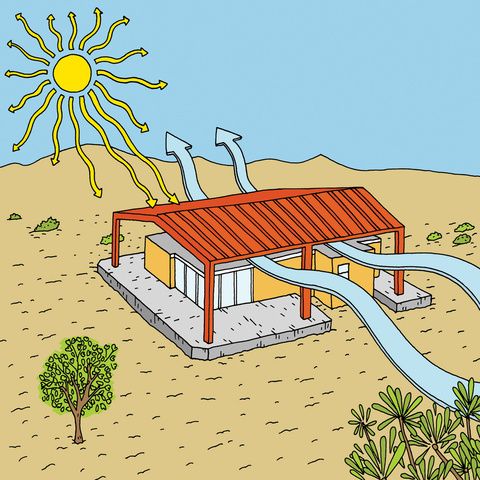
August 11, 2025 – As temperatures rise globally and the cost of energy continues to climb, the search for smarter, more sustainable ways to stay cool is more urgent than ever. While modern air conditioning provides relief, it comes with a high financial and environmental price tag. A simple but brilliant illustration circulating online, however, showcases a powerful alternative: a home designed as a natural “cooling machine,” using the timeless principles of passive design to fight the heat.
This approach, which works in harmony with the natural environment, offers a blueprint for creating comfortable living spaces in hot climates. But the diagram also reveals a critical lesson: to build effectively, one must first understand the specific type of heat they are fighting.
Step 1: Deconstructing the “Cooling Machine”
The provided image, though stylized, perfectly illustrates three universal principles of passive cooling.
- Principle 1: The Giant Umbrella (The Parasol Roof). The most dominant feature is the large, elevated roof that hovers over the main structure like a giant parasol. Its sole purpose is to intercept 100% of the harsh, direct sunlight, leaving the actual living space entirely in the shade. This is the single most effective way to prevent solar heat gain, which is the primary source of overheating in most buildings.
- Principle 2: The Thermal Buffer Zone. The air gap between the outer “fly-roof” and the building’s inner roof is a crucial design element. As the sun beats down, the outer roof gets hot. This heat is transferred to the air in the gap, which then rises and escapes (as shown by the arrows). This process vents the heat away before it can radiate down into the main building, acting as a highly effective thermal buffer.
- Principle 3: The Wind Tunnel (Cross-Ventilation). The diagram clearly shows streams of air flowing through the building’s open core. By strategically placing windows and openings on opposite sides of a structure, a designer can channel natural breezes through the interior. This constant airflow pushes out hot, stagnant air and creates a cooling evaporative effect on human skin, dramatically increasing comfort.
Step 2: The Critical Mistake – Confusing Dry Heat with Humid Heat
While these principles are universal, the diagram depicts a hot-arid environment, like a desert. A builder who copies this design literally in a hot-humid climate, like a tropical region, would be making a significant mistake. The strategies for passive cooling must be adapted based on the presence of humidity.
Designing for Hot-Arid Climates (e.g., US Southwest, North Africa, Middle East):
- Key Challenge: Intense, dry solar radiation and large temperature swings (hot days, cool nights).
- Strategy: Thermal Mass. Buildings in these regions often use thick, heavy materials like adobe, rammed earth, or concrete. These materials have high “thermal mass,” meaning they can absorb the intense heat of the day very slowly. At night, as the desert air cools significantly, the walls release this stored heat back into the interior, keeping it warm.
- Strategy: Small Openings. Windows are often kept small and deeply recessed to minimize the amount of direct sun entering the building.
Designing for Hot-Humid Climates (e.g., US Southeast, Southeast Asia, Central America):
- Key Challenge: High humidity, strong sun, and very little temperature difference between day and night.
- Strategy: Lightweight Construction. Heavy thermal mass is a liability here. Because the nights stay warm and humid, a heavy wall that absorbs heat all day will simply radiate that heat back into the house all night, making it feel like an oven. The ideal design uses lightweight materials (like wood or elevated structures) that cool down quickly as soon as the sun sets.
- Strategy: Maximum Ventilation. With humidity high, the only effective passive cooling strategy is constant air movement. This requires large, operable windows, louvers, and open-plan layouts to encourage cross-ventilation. The goal is to live within the breeze.
- Strategy: Rain Management. These regions often experience torrential rain. Roofs must have a steep enough pitch to shed water quickly, and deep overhangs are needed to protect the walls from constant moisture.
Step 3: An Expert’s View on Climate-Specific Design
“The principles of passive design—controlling the sun and working with the wind—are timeless. But the specific strategies are hyper-local,” says Dr. Elena Vance, a (fictional) expert in sustainable architecture. “The biggest mistake a designer can make is to see ‘hot climate’ on a project brief and apply a generic solution. A building for Phoenix, Arizona, is fundamentally different from a building for Miami, Florida. One must be designed to manage dry heat and cool nights; the other must be designed to shed humidity and survive torrential rain. Understanding that distinction is the first step to creating a truly sustainable and comfortable building.”
Conclusion: The Blueprint for a Smarter Future
This simple diagram is a powerful illustration of how intelligent, low-tech design can create profound comfort and energy savings. It reminds us that before we reach for the air conditioner’s remote, we should first look to the design of the building itself.
By understanding the core principles of passive cooling and, more importantly, by adapting those principles to the specific challenges of the local climate—be it arid or humid—we can build smarter, more resilient, and more comfortable homes. In an era of changing climate and rising energy costs, this ancient wisdom has never been more relevant.